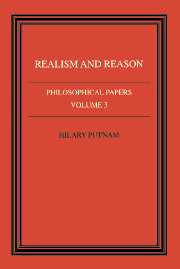Book contents
- Frontmatter
- Contents
- Dedication
- Introduction
- 1 Models and reality
- 2 Equivalence
- 3 Possibility and necessity
- 4 Reference and truth
- 5 ‘Two dogmas’ revisited
- 6 There is at least one a priori truth
- 7 Analyticity and apriority: beyond Wittgenstein and Quine
- 8 Computational psychology and interpretation theory
- 9 Reflections on Goodman's Ways of Worldmaking
- 10 Convention: a theme in philosophy
- 11 Philosophers and human understanding
- 12 Why there isn't a ready-made world
- 13 Why reason can't be naturalized
- 14 Quantum mechanics and the observer
- 15 Vagueness and alternative logic
- 16 Beyond historicism
- Bibliography
- Acknowledgements
- Index
12 - Why there isn't a ready-made world
Published online by Cambridge University Press: 06 January 2010
- Frontmatter
- Contents
- Dedication
- Introduction
- 1 Models and reality
- 2 Equivalence
- 3 Possibility and necessity
- 4 Reference and truth
- 5 ‘Two dogmas’ revisited
- 6 There is at least one a priori truth
- 7 Analyticity and apriority: beyond Wittgenstein and Quine
- 8 Computational psychology and interpretation theory
- 9 Reflections on Goodman's Ways of Worldmaking
- 10 Convention: a theme in philosophy
- 11 Philosophers and human understanding
- 12 Why there isn't a ready-made world
- 13 Why reason can't be naturalized
- 14 Quantum mechanics and the observer
- 15 Vagueness and alternative logic
- 16 Beyond historicism
- Bibliography
- Acknowledgements
- Index
Summary
Two ideas that have become a part of our philosophical culture stand in a certain amount of conflict. One idea, which was revived by Moore and Russell after having been definitely sunk by Kant and Hegel (or so people thought) is metaphysical realism, and the other is that there are no such things as intrinsic or ‘essential’ properties. Let me begin by saying a word about each.
What the metaphysical realist holds is that we can think and talk about things as they are, independently of our minds, and that we can do this by virtue of a ‘correspondence’ relation between the terms in our language and some sorts of mind-independent entities. Moore and Russell held the strange view that sensibilia (sense data) are such mind-independent entities: a view so dotty, on the face of it, that few analytic philosophers like to be reminded that this is how analytic philosophy started. Today material objects are taken to be paradigm mind-independent entities, and the ‘Correspondence’ is taken to be some sort of causal relation. For example, it is said that what makes it the case that I refer to chairs is that I have causally interacted with them, and that I would not utter the utterances containing the word ‘chair’ that I do if I did not have causal transactions ‘of the appropriate type’ with chairs.
- Type
- Chapter
- Information
- Philosophical Papers , pp. 205 - 228Publisher: Cambridge University PressPrint publication year: 1983
- 20
- Cited by



